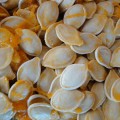
What’s all of this talk about gardening? Didn’t it just turn into winter? Well, a gardener’s work is never done. When we’re not out in the garden, we’re inside the house plotting and planning. At this time of the year, our thoughts turn to seeds and plans for the new year’s garden.
If you’re in garden planning mode, you’re probably thinking about what you’d like to grow and eat this summer. If you’re like me, you may also be planning for excess and thinking about what you’d like to freeze and can. Do you need more zucchini than last year? How about planting some new raspberry bushes? Maybe you’re eagerly considering that patch of yard you could sheet mulch.
Seed Saving Helps You Grow Next Year’s Garden
One thing you might not consider is seed saving. After all, if you do save seeds from your plants, that usually happens once the plants are finished for the season. If you do save seed, you probably just finished tucking those seeds away. So why consider seed saving in January?
Well, if you are ordering seeds, January and February tends to be the time when the seed catalogues arrive. This is an exciting time, since seeds to me are sort of like Christmas presents: tiny packages all wrapped up that open into something wonderful. Actually, I like them much better than Christmas presents!
The time when you’re ordering seeds is the time when you need to think about the seeds that you’ll save. If you’re a savvy and somewhat organized gardener, you can save the seeds from the plants that you grow so that you don’t need to depend quite as much on seed catalogues for your seed supply.
When you have the big red marker out and you’re circling things in the seed catalogue, what do you need to circle to improve your ability to save seeds?
Open Pollinated and Heirloom Seeds
If you’d like to save seeds, choose open pollinated or heirloom varieties instead of hybrid or F1 seeds. While hybrid seeds grow with specific characteristics that you might want in your garden vegetables, such as huge tomatoes or disease-resistant stems, they’re not very useful for seed saving. This is because they’ve been carefully bred for those characteristics, but they won’t retain them in the next generation. If you’re hoping to get more of those big, juicy tomatoes in year two, think again. Instead, get open pollinated seeds and know that you’ll get seeds that will breed true.
Different Species of Squash
If you’d like to save the seeds from your squash plants, do it carefully. When bees move between two squash plants of different types, they bring the pollen with them. Although the squash will grow into normal squash this year, if you save the seeds they will produce funny-looking crosses next year. Before you buy your squash seeds (this includes zucchinis!), check to see what the species names are. If the species is the same, the squash might cross pollinate. If you’d like to grow squash of the same species nearby, or if your neighbor grows a lot of squash and you would like to save seeds from yours, pollinate the squash yourself using a brush that you move between blossoms, then cover the blossoms with a tulle bag found in the wedding section of craft stores. Cinch it gently around the blossom until the fruit has set to avoid cross pollination.
Easy Peasy Seed Saving
Some seeds are simple for the beginning seed saver. These tend to be the seeds that I save the most. These seeds include greens such as lettuce, since I simply let them go to seed, then shake them onto a piece of paper. Peas and beans are easy to dry on the vine, and they’re fun to shell as well. If you’d like to learn how to save seeds this year, start with some of these easier beginner varieties.
Seed saving can turn your seed spending this year into a long-term, productive investment. Do you save seeds from your garden?
Photo: [Featured Image]: Onion seeds for saving. k_hargrav / CC by 2.0








I love this! It’s so true that saving seeds does not have to be as complicated or difficult as many people think it might be.